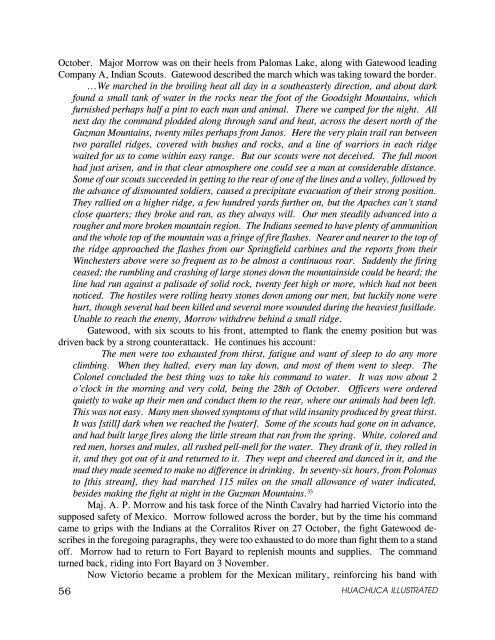Apache Campaigns - Fort Huachuca - U.S. Army
Apache Campaigns - Fort Huachuca - U.S. Army
Apache Campaigns - Fort Huachuca - U.S. Army
You also want an ePaper? Increase the reach of your titles
YUMPU automatically turns print PDFs into web optimized ePapers that Google loves.
October. Major Morrow was on their heels from Palomas Lake, along with Gatewood leading<br />
Company A, Indian Scouts. Gatewood described the march which was taking toward the border.<br />
...We marched in the broiling heat all day in a southeasterly direction, and about dark<br />
found a small tank of water in the rocks near the foot of the Goodsight Mountains, which<br />
furnished perhaps half a pint to each man and animal. There we camped for the night. All<br />
next day the command plodded along through sand and heat, across the desert north of the<br />
Guzman Mountains, twenty miles perhaps from Janos. Here the very plain trail ran between<br />
two parallel ridges, covered with bushes and rocks, and a line of warriors in each ridge<br />
waited for us to come within easy range. But our scouts were not deceived. The full moon<br />
had just arisen, and in that clear atmosphere one could see a man at considerable distance.<br />
Some of our scouts succeeded in getting to the rear of one of the lines and a volley, followed by<br />
the advance of dismounted soldiers, caused a precipitate evacuation of their strong position.<br />
They rallied on a higher ridge, a few hundred yards further on, but the <strong>Apache</strong>s can’t stand<br />
close quarters; they broke and ran, as they always will. Our men steadily advanced into a<br />
rougher and more broken mountain region. The Indians seemed to have plenty of ammunition<br />
and the whole top of the mountain was a fringe of fire flashes. Nearer and nearer to the top of<br />
the ridge approached the flashes from our Springfield carbines and the reports from their<br />
Winchesters above were so frequent as to be almost a continuous roar. Suddenly the firing<br />
ceased; the rumbling and crashing of large stones down the mountainside could be heard; the<br />
line had run against a palisade of solid rock, twenty feet high or more, which had not been<br />
noticed. The hostiles were rolling heavy stones down among our men, but luckily none were<br />
hurt, though several had been killed and several more wounded during the heaviest fusillade.<br />
Unable to reach the enemy, Morrow withdrew behind a small ridge.<br />
Gatewood, with six scouts to his front, attempted to flank the enemy position but was<br />
driven back by a strong counterattack. He continues his account:<br />
The men were too exhausted from thirst, fatigue and want of sleep to do any more<br />
climbing. When they halted, every man lay down, and most of them went to sleep. The<br />
Colonel concluded the best thing was to take his command to water. It was now about 2<br />
o’clock in the morning and very cold, being the 28th of October. Officers were ordered<br />
quietly to wake up their men and conduct them to the rear, where our animals had been left.<br />
This was not easy. Many men showed symptoms of that wild insanity produced by great thirst.<br />
It was [still] dark when we reached the [water]. Some of the scouts had gone on in advance,<br />
and had built large fires along the little stream that ran from the spring. White, colored and<br />
red men, horses and mules, all rushed pell-mell for the water. They drank of it, they rolled in<br />
it, and they got out of it and returned to it. They wept and cheered and danced in it, and the<br />
mud they made seemed to make no difference in drinking. In seventy-six hours, from Polomas<br />
to [this stream], they had marched 115 miles on the small allowance of water indicated,<br />
besides making the fight at night in the Guzman Mountains. 33<br />
Maj. A. P. Morrow and his task force of the Ninth Cavalry had harried Victorio into the<br />
supposed safety of Mexico. Morrow followed across the border, but by the time his command<br />
came to grips with the Indians at the Corralitos River on 27 October, the fight Gatewood describes<br />
in the foregoing paragraphs, they were too exhausted to do more than fight them to a stand<br />
off. Morrow had to return to <strong>Fort</strong> Bayard to replenish mounts and supplies. The command<br />
turned back, riding into <strong>Fort</strong> Bayard on 3 November.<br />
Now Victorio became a problem for the Mexican military, reinforcing his band with<br />
56<br />
HUACHUCA ILLUSTRATED

















